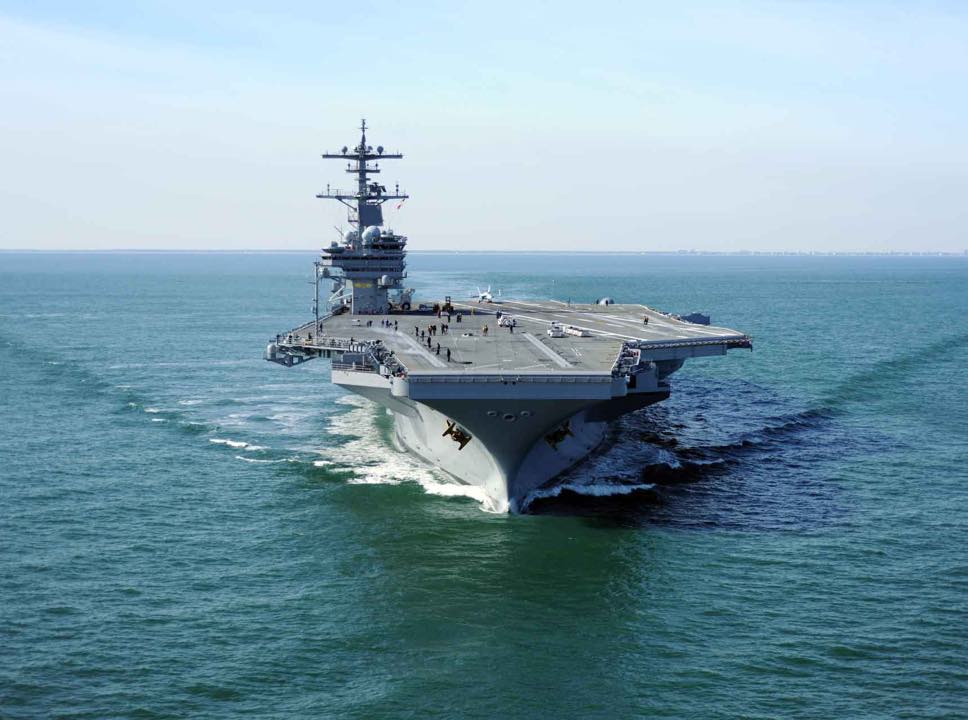George H.W. Bush CVN 77

USS George H.W. Bush (CVN-77)
Propulsion: Two nuclear reactors, four shafts. Length: 1,092 feet (332.85 meters). Beam: 134 feet (40.84 meters) ; Flight Deck Width: 252 feet (76.8 meters). Displacement: Approximately 97,000 tons (87,996.9 metric tons) full load. Speed: 30+ knots (34.5+ miles per hour). Crew: Ship's Company: 3,200 - Air Wing: 2,480. Armament: Two or three (depending on modification) NATO Sea Sparrow launchers, 20mm Phalanx CIWS mounts: (3 on Nimitz and Dwight D. Eisenhower and 4 on Vinson and later ships of the class.). Aircraft: 85.
Construction and Commissioning
The contract to build USS George H.W. Bush (CVN-77) was awarded on January 26, 2001. The ship's construction spanned seven years, during which significant milestones were achieved:
- The keel was laid on September 6, 2003.
- The ship was christened on October 7, 2006.
- USS George H.W. Bush was commissioned on January 10, 2009.
The construction of the ship involved the use of 47,000 tons of structural steel and about a million pounds of aluminum. A modular construction process was employed, forming large individual units of the ship much like interlocking building blocks. These units were welded together to form a module or superlift, with each superlift weighing up to 900 tons.
Following its commissioning in January 2009, USS George H.W. Bush began initial operations and sea trials. These trials tested the ship's systems, capabilities, and crew readiness. The carrier successfully completed flight deck certifications, carrier qualifications, and other essential evaluations, ensuring that the ship was ready for operational deployment.
In May 2010, USS George H.W. Bush embarked on its maiden deployment. The carrier, along with Carrier Air Wing Eight (CVW-8), conducted operations in the Mediterranean Sea and the Arabian Sea. The deployment included participation in various multinational exercises, maritime security operations, and support for Operation Enduring Freedom. The carrier returned to its homeport in Norfolk, Virginia, in December 2010.
From 2011 to 2013, USS George H.W. Bush continued to conduct operations and participate in numerous exercises. In 2011, the carrier was involved in operations in the Arabian Sea, providing air support for coalition forces in Afghanistan. The ship also participated in joint exercises with allied navies, enhancing interoperability and regional security.
In 2012, USS George H.W. Bush underwent maintenance and upgrades to ensure continued operational readiness. The carrier participated in various training exercises and certifications, preparing the crew for future deployments.
In February 2014, USS George H.W. Bush deployed to the U.S. Fifth Fleet area of responsibility, conducting operations in the Arabian Gulf. The carrier supported Operation Enduring Freedom and later played a crucial role in Operation Inherent Resolve, launching airstrikes against ISIS targets in Iraq and Syria. The deployment demonstrated the carrier's ability to project power and provide sustained air support for ground operations. The ship returned to Norfolk in November 2014.
Throughout 2015 and 2016, USS George H.W. Bush underwent a scheduled maintenance period, including a Planned Incremental Availability (PIA) at Norfolk Naval Shipyard. This maintenance period involved overhauls of critical systems, upgrades to combat capabilities, and general upkeep to ensure the carrier's long-term operational readiness. The crew also participated in various training exercises and certifications to maintain their proficiency.
In January 2017, USS George H.W. Bush deployed to the Mediterranean Sea and the Arabian Gulf. The carrier conducted combat operations against ISIS as part of Operation Inherent Resolve, launching numerous sorties and delivering precision airstrikes. The deployment also included participation in multinational exercises with NATO allies, enhancing cooperation and interoperability. The carrier returned to Norfolk in August 2017 after a successful and impactful deployment.
Following the 2017 deployment, USS George H.W. Bush focused on maintaining operational readiness through routine maintenance, training exercises, and certifications. In 2018, the carrier underwent a Drydocking Planned Incremental Availability (DPIA) at Norfolk Naval Shipyard, ensuring the ship remained in peak condition. The crew continued to participate in training exercises, preparing for future deployments and operational requirements.
The COVID-19 pandemic in 2020 brought unique challenges to the crew of USS George H.W. Bush. Despite the global health crisis, the carrier maintained its readiness and continued to support U.S. Navy operations. Strict health protocols were implemented to protect the crew, ensuring the carrier could continue its mission. In 2021, USS George H.W. Bush participated in various exercises and training operations, demonstrating resilience and adaptability.
In 2022, USS George H.W. Bush continued to maintain high readiness levels through scheduled maintenance, training exercises, and preparations for future deployments. The carrier participated in joint exercises with international partners, enhancing interoperability and strengthening alliances. The ship's activities underscored its critical role in supporting U.S. Navy operations and maintaining global maritime security.
